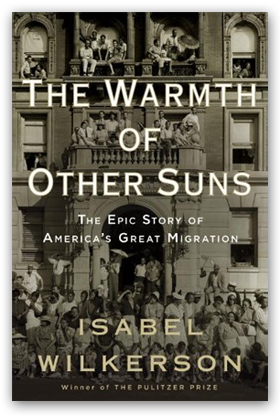
By Isabel Wilkerson
Hardcover, 622 pages
Publisher: Random House, 2010
Between 1915-1970, the United States experienced a seismic shift that changed the demographic, political and cultural the characteristics of this country. Called the Great Migration, it involved millions of African Americans who fled the South and settled in cities in the North and West in search of freedom from racism and economic exploitation. The migration touched the lives of every American and influenced everything from the types of food we eat and the way we speak to the music we listen to and create. My family, like a lot of African American families, was touched by the migration. My grandparents and great-grandparents moved westward to California, settling in towns like San Bernardino, Berkeley, and Oakland. Their presence in this state, like so many others, is evident in the storefront churches, BBQ joints, and even in the Southern accents that have grown faint with time but are still noticeable to any discerning ear.
Here’s an interesting story. When I was attending Adams Junior High School in the El Cerrito hills back in the 1980s, I had a teacher, Mr. Steinberg, who taught history. During a conversation about the migratory nature of language, he asked the class about a slang term that was popular at the time—mack, as in to mack, Mac Dre, or The Mack, a blaxploitation pic of the 1970s. He asked his class of mostly 12 and 13-year-old black kids where the term came from. Since most of us didn’t have a clue, we sat at our desks in stumped silence, before he explained to us that the term was a shortened version of the French word maquereau, which in English means “pimp.” He also explained how the term originated in New Orleans and traveled to California—which makes sense since most Californians who migrated here from the South came out of Louisiana. Though he didn’t mention that something called the Great Migration was the means by which this word made its way out west, he didn’t really have to. The migration was so deeply entrenched in each of our lives that we were aware of it through the influences of the people around us. It shaped us in very real and fundamental ways.
I was reminded of all this while reviewing Isabel Wilkerson’s stunning non-fiction debut, The Warmth of Other Suns: the Epic Story of America’s Great Migration, published in 2010 by Random House. Wilkerson, winner of a Pulitzer in 1994 for feature writing as the Chicago Bureau Chief for the New York Times, employs her deft skills as a journalist to chronicle the lives of the people who participated in the migration, exploring why they left the South and the opportunities and problems they faced in their adopted home states. What emerges is an intimate record of the people who left, presenting a far more personal portrait than most research studies have undertaken to document this important period of American history.
While much of the research about the Great Migration tends to focus on its early years, specifically during World War I, Wilkerson wisely concentrates on the years from the Great Depression to the 1960s, when the migration was still in full swing—at least until the Civil Rights Movement began its push toward social and economic justice in the South. The three subjects who Wilkerson’s book follows left the South for various reasons (though Jim Crow and its accompanying threat of racial violence were the most common reasons for leaving) and at different times during the fifty-some-odd years of the migration, yet what they all share in common is the tremendous courage it took for each of them to leave their homes to strike it out in places that were as foreign to them as Paris was to those black Americans such as Josephine Baker, Richard Wright, and James Baldwin who became European exiles. Wilkerson, who began her research back in the mid-1990s, extensively interviewed hundreds of subjects and their families and friends, narrowing the focus to three very different, but in many ways similar, people: Ida Mae Brandon Gladney, George Swanson Starling, and Robert Joseph Pershing Foster.
The book is structured around the documenting of Gladney, Starling, and Foster’s personal recollections, which Wilkerson tells with the naturalness of a born storyteller. Wilkerson begins with their lives in the South—Mississippi, Florida, and Louisiana respectively; their upbringing in close-knit black communities, the hardships they faced as sharecroppers, migrant fruit pickers, and even as a physician, and the often treacherous undertaking of leaving the south. Wilkerson goes through great detail to illustrate just how dangerous leaving the south could be for many of the migrants. Many had to buy tickets and board trains in neighboring towns where they were not known out of fear of legal and extralegal retribution, even going so far as to keep family members in the dark of their plans. Other migrants hopped trains as hoboes, heading north or west if they couldn’t afford the tickets or were fleeing danger. Foster undertook the lengthiest and most dangerous trek of the three when he drove all the way from Madison, Louisiana—his hometown—to California, battling fatigue, Jim Crow, and the disappointment that California wasn’t going to be the land of “milk and honey” that he always dreamed. After being rejected by motels in Arizona, past the Jim Crow line, he breaks down— “[t]he exhaustion, the rejection, the unwinding of his dreams in a matter of minutes…all caught up with him at once.” Yet once Pershing, Gladney, and Starling reach their destination points, they commit to building new lives in the North and West, even as they face different forms of hardship and racism.
Wilkinson is successful in presenting the stories of each individual with the level of detail and depth that are worthy of biography. Yet The Warmth of Other Suns is more than biography, but a historical record of the Great Migration through the very intimate and minute details of the people she chronicles. These stories are grounded even further with facts and statistics that dispel the myth that the southern migrants brought social pathologies to cities in the North. As she writes, “[c]ompared to the northern blacks already there, the migrants were more likely to be married and remain married, more likely to raise their children in two-parent households, and more likely to be employed.” Wilkinson also shows that once the migrants reached their ports of destination, they faced other and far more complex problems of racism, unemployment, crime, and poverty, as a generation of young people who had never lived in the South failed to learn the lessons of their parents and grandparents.
Wilkerson’s book is dense, and no synopsis could do justice to the terrific job she does in recording these lives. She follows her three subjects well into old age and death, revealing an expansive portrait of the migration that includes the lingering reverberations that followed afterward. In so doing, she reveals America through the 20th century, highlighting the enormous changes the Great Migration had on society, particularly in the south, which was forced to confront its Jim Crow legacy. But Wilkerson’s greatest achievement is presenting three indelible individuals who soar off the page and become as real as any family member or friend. It’s hard not to admire Gladney, Foster, and Starling for their courage and tenacity. Wilkerson allows them to be fully-fleshed, complex, and flawed people who may not be fully aware of their place in history—but certainly are aware of their own responsibilities to their families and communities in both the South and their chosen homes. The Warmth of Other Suns is an amazing literary achievement that ought to be a part of the canon of African American literature and great works of social history in this country.







I loved this book. Savored every page. Isabel is the consummate storyteller. She pulled the reader in to every one of the main character’s lives and you loved them in spite of their flaws, you took the journey with them and you mourned their losses as if they were your own. Can’t wait to see what she comes up with next.
Thanks for suggesting this book!I’ve read this book two times as an African American I feel so blsseed after reading these types of books. Its such a shame that our text books omit the Journey and Fight Blacks endured years and years ago.